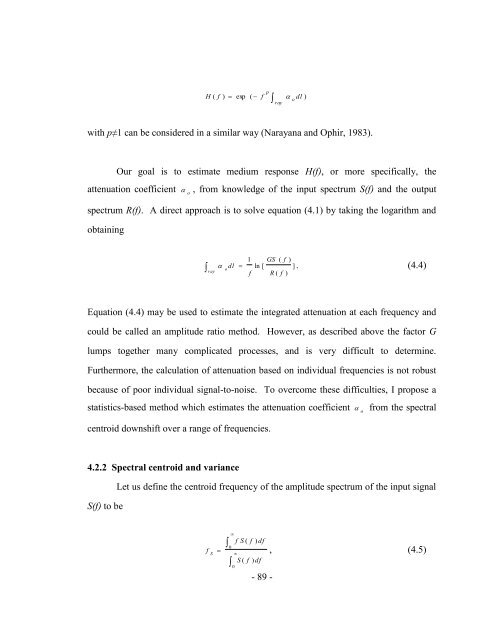My PhD Thesis, PDF 3MB - Stanford University
My PhD Thesis, PDF 3MB - Stanford University
My PhD Thesis, PDF 3MB - Stanford University
You also want an ePaper? Increase the reach of your titles
YUMPU automatically turns print PDFs into web optimized ePapers that Google loves.
H ( f ) exp ( f p<br />
- 89 -<br />
ray<br />
o dl<br />
with p≠1 can be considered in a similar way (Narayana and Ophir, 1983).<br />
Our goal is to estimate medium response H(f), or more specifically, the<br />
attenuation coefficient o , from knowledge of the input spectrum S(f) and the output<br />
spectrum R(f). A direct approach is to solve equation (4.1) by taking the logarithm and<br />
obtaining<br />
r<br />
ay<br />
o dl 1<br />
f<br />
GS ( f )<br />
ln [<br />
R ( f )<br />
)<br />
] . (4.4)<br />
Equation (4.4) may be used to estimate the integrated attenuation at each frequency and<br />
could be called an amplitude ratio method. However, as described above the factor G<br />
lumps together many complicated processes, and is very difficult to determine.<br />
Furthermore, the calculation of attenuation based on individual frequencies is not robust<br />
because of poor individual signal-to-noise. To overcome these difficulties, I propose a<br />
statistics-based method which estimates the attenuation coefficient o from the spectral<br />
centroid downshift over a range of frequencies.<br />
4.2.2 Spectral centroid and variance<br />
S(f) to be<br />
Let us define the centroid frequency of the amplitude spectrum of the input signal<br />
f S <br />
<br />
<br />
0<br />
<br />
<br />
0<br />
f S ( f ) df<br />
S ( f ) df<br />
, (4.5)
















